Cyber Crime Awareness among Youth in Udupi District
Pradeep Loyed Martis P* and Arjun MSA
Department of Criminology and Forensic Science, India
Submission: May 9, 2018;Published: May 16, 2018
*Corresponding author: Pradeep Loyed Martis, Department of Criminology and Forensic Science, School of Social Work, RoshniNilaya, Mangaluru, India, Email: pradeeployedmartis@gmail.com
How to cite this article: Pradeep L M P,Arjun M.Cyber Crime Awareness among Youth in Udupi District J Forensic Sci & Criminal Invest. 2018; 8(5): 555750. DOI:10.19080/JFSCI.2018.04.555750.
Abstract
The aim of the study is to analyze the awareness of cybercrime among youths in Udupi district. In recent years cybercrime is an enormous challenge in all areas. To prevent from being victim of cybercrime everyone must know about cyber-crimes and safety measures to protect themselves. A well-structured questionnaire survey method was applied to analyze the youth’s awareness in the area of cyber-crime. This survey is conducted in Udupi district and the sample size was 300 students. This survey examines the youth’s awareness about cyber-crimes and some suggestions are set forth to overcome these issues.
Keywords: Cyber-crime; Awareness; Youth
Introduction
According to Narendra Modi “Cyber related risks are a global threat of bloodless war. India can work towards giving world a shield from the threat of cyber warfare”. The internet is one of the most sophisticated technologies created. The internet and its related technologies are constantly evolving. The number of internet users is increasing steadily around the globe. Internet offers great benefit to society but also present opportunities for crime using new and highly sophisticated technology tools. Today email and websites have become the preferred means of communication. Cyber-crime is defined as the “illegal activity done using computer system and the internet” which is punishable by law. With increasing internet penetration, cyber-crimes have also increased in the last few years. Between 2011 and 2015, the number of cyber-crimes registered in the country has gone up to 5 times. Maharashtra and Uttar Pradesh alone encountered 1/3rd of these crimes.
Cyber-crime in India is registered under three broad heads, the IT Act, Indian Penal Code (IPC) and other State Level Legislation’s (SLL) with increasing mobile and internet penetration in the country, cyber-crimes have also increased proportionately. Between 2011 and 2015, more than 32,000 cyber-crimes were reported across the country. More than 24,000 cases were registered under IT act and the remaining under the various sections of IPC and other State Level Legislations. Cyber-crime also called computer crime, the use of a computer as an instrument to further illegal ends, such as committing fraud, child pornography (Table 1). stealing identities, violating privacy. Cyber-crime, especially through the internet, has grown in importance as the computer has become central to commerce, entertainment and government. Cyber-crime mainly consists of unauthorized access to computer systems, data alterations, data destruction, and theft of intellectual property. Most cyber-crime is an attack on information about individuals, corporations or governments.

Although the attacks do not take place on a physical body, they do take place on the personal or corporate virtual body, which is the set of information attributes that define people and institutions on the internet. Cyber-crime also includes non-monetary offenses such as creating and distributing viruses on other computers or posting confidential business information on the internet. Cyber security plays an important role in the on-going development of information technology, as well as Internet services. Enhancing cyber security and protecting critical information infrastructures are essential to each nation’s security and economic well-being. Making the Internet safer has become integral to the development of new services as well as government policy. Recently, software tools are being used to automate attacks. With the help of software a single offender can attack thousands of computer systems in a single day using one computer. If the offender has access to more computers he/she can increase the scale still further. Since most of these software tools use pre-set methods of attacks, not all attacks prove successful. Users that update their operating systems and software applications on a regular basis reduce their risk of falling victim to these broad-based attacks, as the companies developing protection software analyse attack tools and prepare for the standardized hacking attacks [1].
Materials and Methods
Ethical Statement
I hereby declare that this research project entitled “Cyber Crime Awareness among Youth in Udupi District” is a bona-fide research carried out by me under the guidance of Mr arjun M. S, Assistant Professor, Department of Criminology and Forensic science, school of Social Work, Roshni Nilaya Mangaluru. The aim of the research to find out the cyber-crime awareness among youths in Udupi district Figure 1.

Objective
Any study must yield information which will be helpful for an individual or a group at large. Therefore, to reach out a particular conclusion and to find out a solution it is essential to set the objectives. The objectives of the study are as follows:
a. To present the profile of the respondents for the study.
b. To study the level of awareness of cyber-crime among youths in Udupi district
Problem Statement
Cyber-crime in India is growing exponentially and many youths are being the victim of cyber-crime. People use internet without the proper awareness and it is very important for every user to understand the risk. Awareness towards cyber-crime is important and Cyber-crime knowledge is necessary to stop being victim (Table 2).

Is there awareness on cyber-crime among youths in Udupi district?
Research Design: The research design is a conceptual structure within which the research study is undertaken. The preparation of such design facilitates research to be as effective as possible yielding maximum information. Descriptive Research Design was employed for the present study.
Scope of the Study: The present study was an attempt to find out cyber-crime awareness among youths in Udupi district. The study provides overall basics of cyber world and cyber related crimes. The study mainly focuses on providing awareness towards cyber-crime and helps the user from being victim of cyber-crime. Cyber-crime is increasing day by day and people are falling victims of cyber-crime. The lack of awareness towards cyber-crime affects the public to respond towards cyber-crime. This study aims to know the awareness about cyber-crime among youth and provide them knowledge towards cyber-crime.
Universe Sample and Sampling Technique: Age of the respondents was distributed from 16-30 years. The respondents of the study were taken from Udupi district. The respondents were divided based on education qualification i.e. PUC, Graduation and Post-Graduation, 100 respondents from PUC, 100 respondents from Graduation and 100 respondents from Post-Graduation. Therefore, a total of 300 respondents were chosen based on simple random sampling. Both males (150) and female (150) respondents were considered for the study (Table 3).
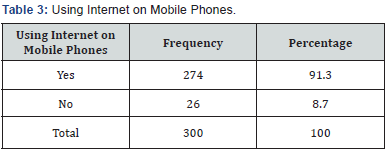
Tools of Data Collection: A tool is an aid with necessary and relevant information could be gathered systematically to the subject matter. The Questionnaire method was the tool of data collection, which was used by the investigator for the purpose of collecting data from the respondents. Variables were selected based on problems identified.
Data Collection and Procedure: The investigation was based on primary data and information for the present study was collected from 300 respondents. The respondents were divided based on their education qualification i.e. PUC, Graduation and Post-Graduation. The data was collected by simple random sampling method. Opinion and views of the respondents were collected through the Questionnaire method. The investigator after building a good rapport with the respondents explained the purpose, importance and significance of the study (Table 4). A consent form was signed from each of the respondents. The questionnaire was filled in the presence of investigator so that the investigator could clarify the doubts of respondents regarding the questions Figure 2.

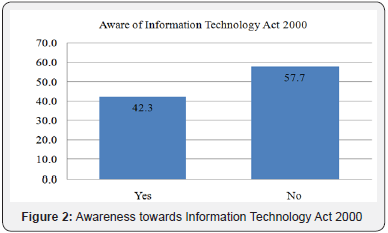
Results and Discussion
It is seen that majority of the respondents (99.7%) use internet and 0.3% of respondents don’t use internet.
Respondents were asked about the awareness of the word “Internet”. Majority of the respondents (94.3%) were aware of the word “Internet” and 5.7% were not aware of the word “Internet”. It is seen that the majority of the respondents (33.3%) spend 3 hours on the internet. Further 32.7% spend 5 and more hours on the internet, 25.3% spend 2 hours on the internet and 8.3% spend 1 hour on the internet and 0.3% of the respondents don’t use internet. It is seen that majority of the respondents (91.3%) use internet on mobile phones and 8.7% don’t use internet on mobile phones. Respondents were asked about the awareness towards cyber- crimes, it is seen that, majority of the respondents (76.3%) are aware of cyber-crimes and 23.7% are not aware of cyber-crimes (Table 5). Majority of the respondents (44%) don’t know about different kinds of cyber- crime, this states that there is less awareness among different types of Cyber-crimes. 34.3% of the respondents know about “Hacking”, 7.7% of the respondents know about “Credit Card Frauds”, 5% of the respondents know about “Phishing”, 2.7% of the respondents know about “Cyber Stalking”, 1.6% of the respondents know about “Cyber Bullying”, 1.3% of the respondents know about “Spam Mails”, 1% of the respondents know about “Morphing”, 0.7% of the respondents know about “Denial of Service” and “Defamation” and 0.3% of the respondents know about “Online Fraud”, “Identity Theft” and “Cyber Terrorism” Figure 3.
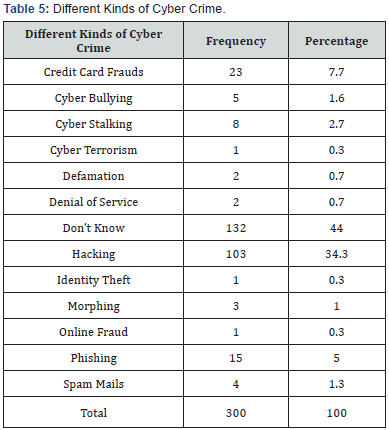
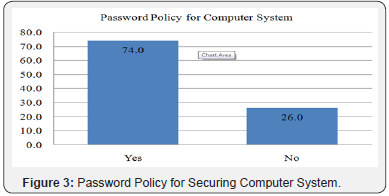
Majority of the respondents (57.7%) are not aware of the Information Technology Act 2000 and 42.3% are aware of the Information Technology Act 2000 (Table 6). Respondents were asked whether they use password policy for computer system. 74% of the respondents use password policy for securing computer system and 26% of the respondents don’t use password policy for securing computer system. Majority of the respondents (40.3%) will not change password, 32.7% of the respondents will change the password yearly, 22.3% of the respondents will change the password monthly and 4.7% will change the password weekly. Respondents were asked whether they use same password for all accounts. Majority of the respondents (65%)do not use same passwords for all accounts and 35% of the respondents use same passwords for all accounts Respondents were asked regarding the prevention of cyber-crime through education. 79.7% of the respondents answered that education would prevent cyber-crime and 20.3% answered that education would not prevent cyber- crime (Table 7) Figure 4.
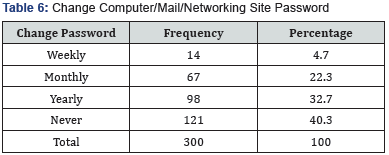

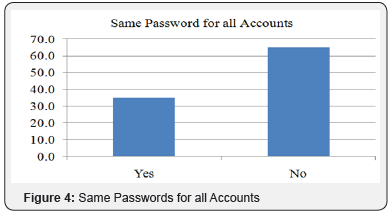
Conclusion
This study which focuses on Awareness towards Cyber- Crime among Youth in Udupi District shows that the respondents are generally lacking in the awareness towards Cyber-crime. The study proves that the youths in Udupi district are not thoroughly aware of cyber-crimes. The lack of awareness is observed drastically in case of protection towards their personal computers and laptops. Other than hacking, a quiet majority of users are not aware of crimes like cyber stalking, mobile hacking, Deep web crimes, copyright violation, cyber bullying, phishing, child soliciting and abuse, sharing disturbing content of pornography, identity theft, cyber-squatting etc.
Acknowledgement
First I would like to thank almighty god for showering his blessings, which helped me to make this research reality. I thank my academic Guide, Mr.Arjun M S, Lecturer, PG Department of Criminology ad Forensic Science, School of Social Work, Mangalurufor his counsel and guidance during the preparation of this dissertation. I would like to thank Ms.Saritha D’Souza, Head of the PG Department of Criminology and Forensic Science, School of Social Work, Mangaluru, for her kind hearted guidance in my research work.. My sincere thanks to Dr. Sophia N. Fernandes, Principal, School of Social Work, Mangaluru, for giving me the opportunity to undertake this study. I thank Shimona Mae Dias, AkashDezlie Machado and Monika Hegde for helping me in my research. I thank my family for constant encouragement and support throughout my life and academic careers.






























